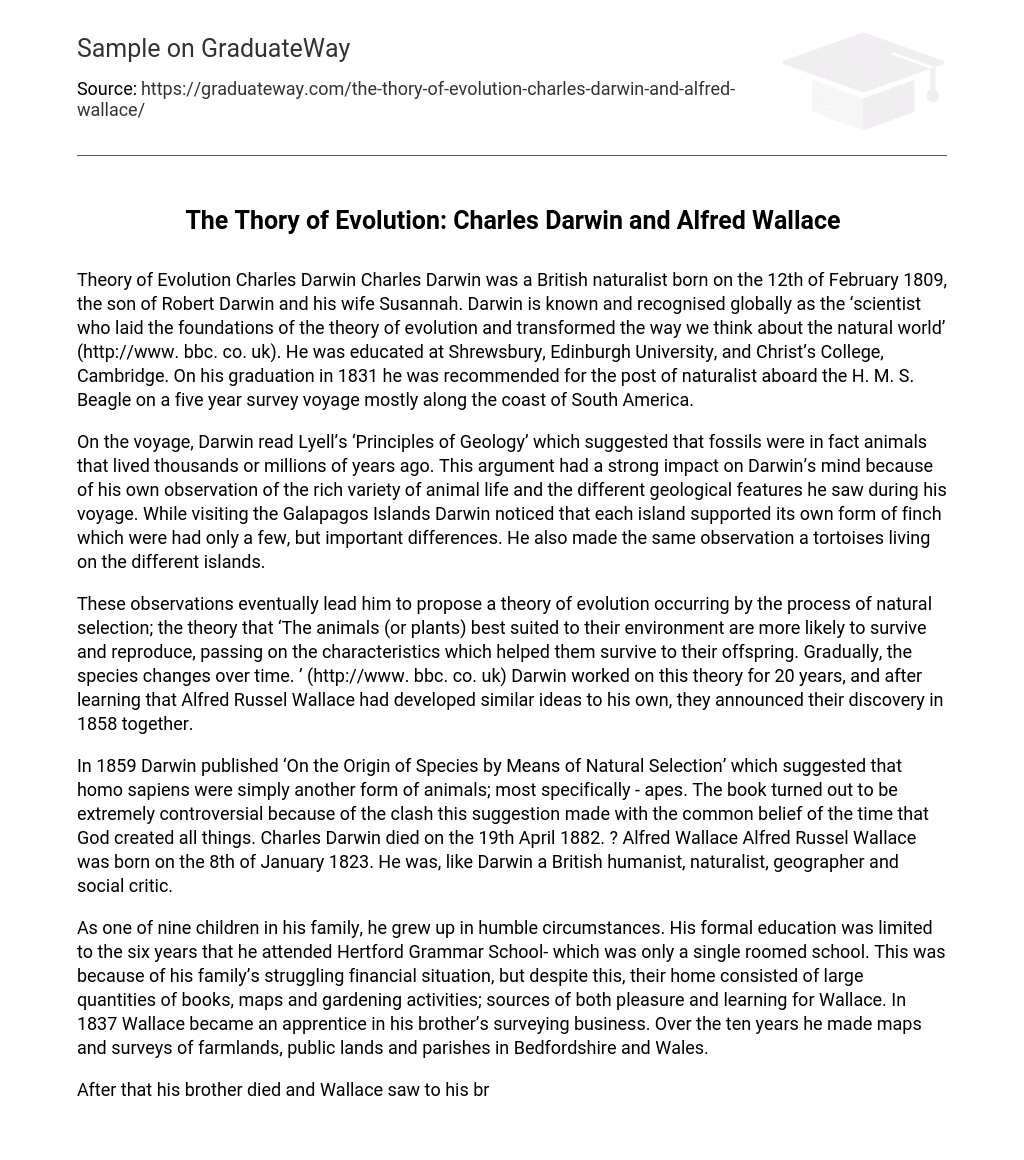Theory of Evolution Charles Darwin Charles Darwin was a British naturalist born on the 12th of February 1809, the son of Robert Darwin and his wife Susannah. Darwin is known and recognised globally as the ‘scientist who laid the foundations of the theory of evolution and transformed the way we think about the natural world’ (http://www. bbc. co. uk). He was educated at Shrewsbury, Edinburgh University, and Christ’s College, Cambridge. On his graduation in 1831 he was recommended for the post of naturalist aboard the H. M. S. Beagle on a five year survey voyage mostly along the coast of South America.
On the voyage, Darwin read Lyell’s ‘Principles of Geology’ which suggested that fossils were in fact animals that lived thousands or millions of years ago. This argument had a strong impact on Darwin’s mind because of his own observation of the rich variety of animal life and the different geological features he saw during his voyage. While visiting the Galapagos Islands Darwin noticed that each island supported its own form of finch which were had only a few, but important differences. He also made the same observation a tortoises living on the different islands.
These observations eventually lead him to propose a theory of evolution occurring by the process of natural selection; the theory that ‘The animals (or plants) best suited to their environment are more likely to survive and reproduce, passing on the characteristics which helped them survive to their offspring. Gradually, the species changes over time. ’ (http://www. bbc. co. uk) Darwin worked on this theory for 20 years, and after learning that Alfred Russel Wallace had developed similar ideas to his own, they announced their discovery in 1858 together.
In 1859 Darwin published ‘On the Origin of Species by Means of Natural Selection’ which suggested that homo sapiens were simply another form of animals; most specifically – apes. The book turned out to be extremely controversial because of the clash this suggestion made with the common belief of the time that God created all things. Charles Darwin died on the 19th April 1882. ? Alfred Wallace Alfred Russel Wallace was born on the 8th of January 1823. He was, like Darwin a British humanist, naturalist, geographer and social critic.
As one of nine children in his family, he grew up in humble circumstances. His formal education was limited to the six years that he attended Hertford Grammar School- which was only a single roomed school. This was because of his family’s struggling financial situation, but despite this, their home consisted of large quantities of books, maps and gardening activities; sources of both pleasure and learning for Wallace. In 1837 Wallace became an apprentice in his brother’s surveying business. Over the ten years he made maps and surveys of farmlands, public lands and parishes in Bedfordshire and Wales.
After that his brother died and Wallace saw to his brother’s business. After reading about the adventures of famous naturalist travellers, including Charles Darwin, he travelled to Brazil in 1848 with his friend Henry Bates. This would be the beginning of many ventures to come. Such ventures were funded by collecting rare wildlife for museums and private collections. He spent four years traveling, collecting, mapping, drawing, and writing in unexplored regions of the Amazon River basin, meanwhile studying the languages and habits of the people he encountered.
From 1854, Wallace spent eight years traveling among islands in the Malay Archipelago. Here, he collected specimens for his research as well as wrote numerous scientific articles, two of which dealt with he origin of new species. The first of these, published in 1855 concluded that ‘ “every species has come into existence coincident both in space and time with a pre-existing closely allied species. ” ’ (quote taken from http://www. britannica. om) He then suggested that ‘new species arise by the progression and continued divergence of varieties that outlive the parent species in the struggle for existence’. (http://www. britannica. com) In 1858 he sent a paper outlining his ideas to Darwin, who realised the similarity between Wallace’s theory and his own. Darwin then sent Darwin’s previous writings as well as Wallace’s paper to the Linnean Society. These were then published as an article entitled ‘On the Tendency of Species to Form Varieties; and on the Perpetuation of Varieties and Species by Natural Means of Selection. On his return he married, had three children and published a narrative of his story entitles ‘The Malay Archipelago: The :and of the Orang-Tan, and the Bird of Paradise’ as well as ‘Contributions to the Theory of Natural Selection. ’ In his writings was the belief, which was contrary to that of many of his colleagues, that higher faculties of human beings could not be accounted for by natural selection. Wallace wrote and published 21 books in total, as well as a list of his articles, essays, and letters which altogether made up more than 700 items. He also received several awards. He died on November 7th, 1913.





